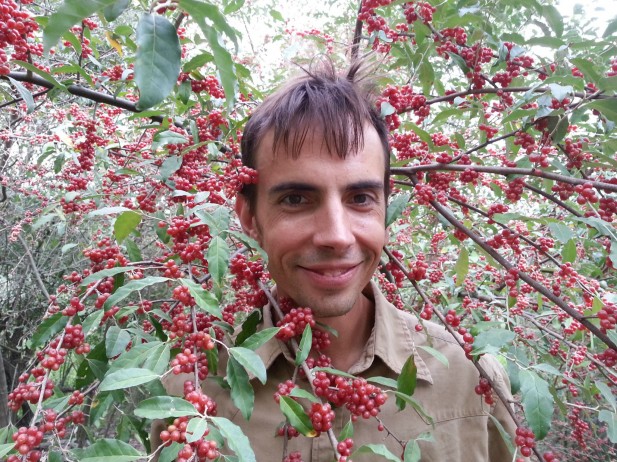Autumn Berry Inspired won Inspire Business Center’s monthly start-up competition to obtain office space in Chicago’s West Loop – giving this new food trend a greater chance to make a debut in Chicago.

Autumn Berry Inspired founder Dustin Kelly has been studying the autumn berry for seven years, and is finding a greater potential for profit. (Photo Courtesy: Dustin Kelly)
Just as goji berries and açaí berries have infiltrated food and health trends, the autumn berry is making a debut as Chicago’s newest and trendiest fruit this fall.
An autumn berry producer and distributor won the hearts of an intimate Chicago start-up crowd on Thursday, April 4. Attendees at the Inspire start-up competition voted to give the Urbana-based producer a new home in Chicago at Inspire Business Center in West Loop.
“It was fantastic to get the acceptance and understanding of Chicago entrepreneurs,” said Dustin Kelly, CEO and founder of Autumn Berry Inspired.
Kelly has lived on a five-acre farm in Urbana since 2004, where he discovered that the small, red berry is not the poisonous fruit that many believed it was.
In fact, Kelly said the fruit is quite nutritious. He said they can be used as a vitamin supplement and can make way for new, creative recipes. The small, red, tangy berries are packed with a rich variety of vitamins, antioxidants and cancer-fighting lycopene.
The process turns “deserted farmlands into productive orchards,” said Gina Biernacki, the company’s marketing executive. The berries are grown on an invasive tree that was brought to North America by the US government. With nitrogen-fixing roots, the plant renews the land it grows on, Biernacki said.
“It’s an invasive tree and we don’t condone anyone planting it or spreading it, we want to use what’s already there,” Biernacki said.
“It’s good for landowners with deserted farmlands that are going to waste and their land is underutilized,” she said. Taking the berries prevents the spread of the trees, and existing trees provide enough berries for a profitable outlook. Kelley said it is important for farmers and researchers to find ways to utilize wild resources such as the autumn berry.
“It’s time to look into perennial poly-cultures as a new agricultural paradigm and as something that’s much better for the environment and much better for people and communities,” Kelly said.
Besides environmental and economic benefits in utilizing this berry, Biernacki outlined that the plant is also good for consumers.
“With the food industry these days, there are a lot of artificial ingredients and it’s hard to find organic products,” Biernacki said. She said once she began working with the company, her food purchasing habits have changed, with a greater appreciation for locally grown, fair-trade and organic foods.
Now, autumn berries can be purchased in the form of fruit leather, jam and frozen berries through the Common Ground Food co-operative, Urbana’s market at Lincoln Square, Big Grove Tavern or directly from Autumn Berry Inspired.
While the US Department of Agriculture released research about the trees in 2002, Kelly said there still remains a greater need for farmers and entrepreneurs to utilize the berries. Kelly and his team of two are working to spread awareness about the trees to farmers, researchers, restaurants, stores and consumers nationwide.
“We want to grow organically, slowly, and grow from a network of connections and communities and not grow just by somebody buying up the idea and putting it down on a national scale,” Kelly said.
Furthermore, the trees are accessible and easy to spot. The company uses Google maps to locate trees and Biernacki said the company is working to develop harvesting machinery.
They are expanding throughout Illinois and Michigan, but the company has a great outlook to continue growing throughout North America. “The berries really are everywhere, especially in the West and the North East,” Biernacki said. Kelly said the Autumn Berry Inspired project has room for national expansion, but also provides a good platform for other autumn berry companies to launch.
But the most exciting news: The Autumn Berry Inspired team will be launching a new host of products with the September harvest, and is casting a wide net of partnerships with well-known Chicago restaurants that are creating unique recipes from the new berry.
Autumn Berry Inspired has formed six partnerships thus far. Consumers can enjoy autumn berry cream cheese at Schmaltz Deli in Naperville, and through autumn berry ice cream from artisan ice cream maker, Ruth and Phil’s. The company expects up to 20 partnerships by the end of the summer, and far more moving into next year after the September harvest.
Biernacki said the company is also looking into partnering with Chicago farmers markets (such as the Green City Market) and Whole Foods, where consumers can experience this new fruit through autumn berry cream cheese, tea, wine, beer, ice cream and yogurt and chocolate covered candy.
The project has “definitely surpassed expectations,” Kelly said. “I’m now seeing that there’s a lot more that we can do, and it’s all happening at a good pace.”
For more information: Visit www.autumnberryinspired.com









